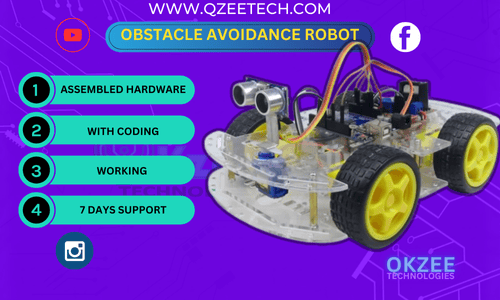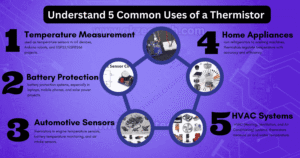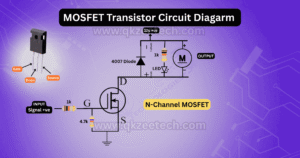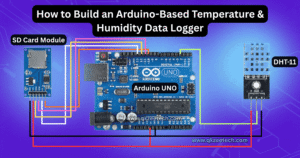Obstacle Avoidance Robot Car Using Arduino, L298, Ultrasonic Sensor, and 4-Wheel Car Chassis Complete Guide
Introduction to Obstacle Avoidance Robot Car
An obstacle avoidance robot car is a smart vehicle designed to detect and avoid obstacles in its path using sensors and Arduino programming. This project is ideal for beginners, students, and hobbyists interested in DIY projects. Whether you’re working on engineering projects, final year projects, or simply exploring Arduino projects for fun, this guide will walk you through the process step by step. If you’re located in Lahore, Pakistan, or elsewhere, you can easily find the components online at QKZee Technologies.ble environments, making it a favorite among students, DIY enthusiasts, and professionals working on engineering projects.
Key Components for the Robot Car
Before we start, gather the following components, all available at qkzee Technologies‘ online shop:
Arduino Board
An Arduino board serves as the brain of the robot. It’s a great and easy way for students and hobbyists to learn robotics and coding.
L298 Motor Driver Module
The L298 motor driver controls the direction and speed of the motors, allowing the robot to move forward, backward, and turn.
Ultrasonic Sensor (HC-SR04)
The ultrasonic sensor detects obstacles ahead by measuring the distance from the robot to nearby objects using sound waves.
4-Wheel Car Chassis
This sturdy chassis holds all the components and allows for smooth movement. It is perfect for school projects and engineering services alike.
You can purchase all of these components at QKZeeTech, a leading provider of sensors, modules, and electronics in Lahore, Pakistan.
How Obstacle Avoidance Works
The Arduino obstacle avoidance robot uses an ultrasonic sensor to detect objects in its path. When an obstacle is detected, the robot changes direction to avoid it, making it an excellent project for science students interested in learning technologies and sensors.
Click Here to buy the complete Assembled Car
understanding the Arduino Board
Why Arduino is Popular for Robotics Projects
Arduino is widely used for DIY projects because it’s open-source, affordable, and easy to learn, especially for those starting out with engineering projects.
Key Features of the Arduino UNO
- 14 digital input/output pins
- USB interface for easy programming
- Compatibility with a wide range of sensors and actuators
L298 Motor Driver: Controlling Motors
What is the L298 Motor Driver?
The L298 motor driver allows the Arduino to control the car’s motors. This module is capable of driving two motors simultaneously, making it a popular choice for Arduino projects.
Wiring the L298 with Arduino
The L298 module connects directly to the Arduino, controlling the direction of the motors. This is key to allowing the robot to turn and avoid obstacles.
- IN1 to Arduino pin 8
- IN2 to Arduino pin 9
- IN3 to Arduino pin 10
- IN4 to Arduino pin 11
Ultrasonic Sensor: Detecting Obstacles
How the Ultrasonic Sensor Works
The ultrasonic sensor measures the distance between the robot and an object by emitting sound waves and detecting the reflection.
Connecting the HC-SR04 to Arduino
- VCC to 5V on the Arduino
- GND to GND on the Arduino
- Trig to pin 12 on the Arduino
- Echo to pin 13 on the Arduino
4-Wheel Car Chassis Setup
Features of a 4-wheel Car Chassis
This chassis allows the robot to move smoothly over different surfaces, and it provides ample space for mounting electronics. It’s perfect for beginners learning how to assemble Arduino projects.
How to Assemble the Chassis
Follow the provided instructions to attach the motors and wheels securely. Ensure the chassis is level for smooth operation.
Power Supply for the Robot Car
For this project, a battery pack of 6V to 12V will suffice. Ensure you are using a power source that is compatible with both the Arduino and the motor driver to avoid damaging the components.
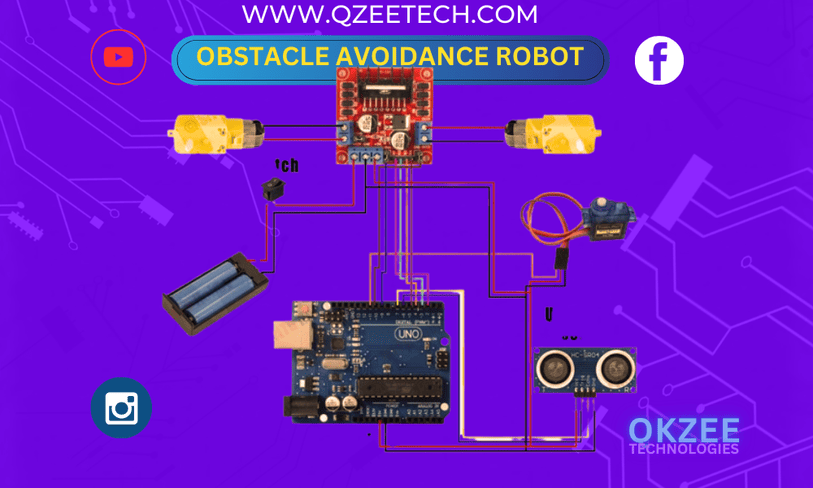
Wiring Everything Together
Connecting the Motors
Connect the motor wires to the L298 motor driver, which will control the speed and direction of the robot’s wheels.
Connecting the Ultrasonic Sensor
Mount the ultrasonic sensor at the front of the robot, making sure it faces forward to detect obstacles effectively.
Arduino Code for Obstacle Avoidance
Below is the Arduino code that makes your robot avoid obstacles. It reads data from the ultrasonic sensor and adjusts the robot’s movement accordingly.
#define trigPin 12
#define echoPin 13
#define in1 8
#define in2 9
#define in3 10
#define in4 11
long duration;
int distance;
void setup() {
pinMode(trigPin, OUTPUT);
pinMode(echoPin, INPUT);
pinMode(in1, OUTPUT);
pinMode(in2, OUTPUT);
pinMode(in3, OUTPUT);
pinMode(in4, OUTPUT);
Serial.begin(9600);
}
void loop() {
// Send a pulse to the ultrasonic sensor
digitalWrite(trigPin, LOW);
delayMicroseconds(2);
digitalWrite(trigPin, HIGH);
delayMicroseconds(10);
digitalWrite(trigPin, LOW);
// Measure the time for the echo
duration = pulseIn(echoPin, HIGH);
// Calculate the distance
distance = duration * 0.034 / 2;
// If an obstacle is detected within 20 cm
if (distance < 20) {
// Move backward
digitalWrite(in1, LOW);
digitalWrite(in2, HIGH);
digitalWrite(in3, LOW);
digitalWrite(in4, HIGH);
delay(500); // Reverse for half a second
// Then turn left
digitalWrite(in1, LOW);
digitalWrite(in2, HIGH);
digitalWrite(in3, HIGH);
digitalWrite(in4, LOW);
delay(500); // Turn left for half a second
} else {
// Move forward
digitalWrite(in1, HIGH);
digitalWrite(in2, LOW);
digitalWrite(in3, HIGH);
digitalWrite(in4, LOW);
}
}
Testing and Tuning the Robot Car
Once the code is uploaded to the Arduino, place your robot on a flat surface and test its ability to detect and avoid obstacles. If necessary, adjust the delay times in the code for more accurate movement.
Common Troubleshooting Tips
- Robot not moving properly? Check your motor connections and make sure the battery is charged.
- Sensor not detecting obstacles? Verify the connections to the ultrasonic sensor and ensure it is mounted correctly.
Where to Buy Components for Your Robot Car
Looking for affordable components for this Arduino project? Check out QKZee Technologies, an online shop in Lahore, Pakistan, offering the best components for students and DIY projects. Whether you’re looking for sensors, modules, or other electronics at a cheap price, they’ve got it all. Visit them at QKZeeTech.
Conclusion
Building an obstacle-avoidance robot car is a fantastic way to learn about engineering, coding, and robotics. It’s an engaging project for beginners, science students, and anyone interested in an Arduino project or a simple DIY project; this module offers both reliability and versatility.
What is the role of the ultrasonic sensor in the robot?
The ultrasonic sensor detects obstacles in front of the robot by measuring the distance between the sensor and objects.
Can I use a different motor driver instead of L298?
Yes, but ensure it’s compatible with your motors and Arduino.
What battery should I use?
A 6V to 12V battery pack is suitable for most robot cars using an Arduino and L298 motor driver.
Why is my robot not moving properly?
Double-check your wiring, especially the motor connections and the power supply.
Where can I buy Arduino and other components for the robot?
You can purchase these components from [QKZeeTech] https://www.qkzeetech.com/shop-2

